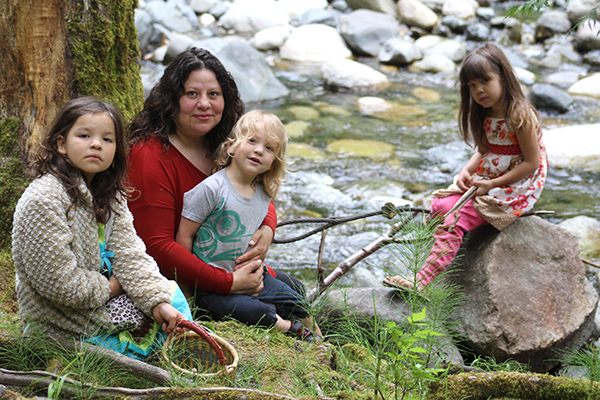
When Nitanis Desjarlais spent time with her family living “off the grid”, she learned more about her own values, heritage and the way she wants to live. She realized her passion lies in foraging for Indigenous foods and learning how the Nuu-chah-nulth language plays an integral role in sustainability and education. Now she is sharing the knowledge she has learned on her own with others.
In 2010, Nitanis and her husband, John Rampanen, introduced a strictly Indigenous diet to their household, now a family of eight children. She spent that time learning what plants in the area are Indigenous, which ones are edible and how they grow through the seasons.
“I discovered my love of picking berries and wanted to do that full-time,” Nitanis said. “We wanted to see if we could do it and survive the winter like our ancestors. So we pushed up a level of learning by doing. By then we had the confidence we could live year-round on an all-Indigenous diet.”
Living in Port Alberni, the couple moved to Tofino as a stepping stone to more remote living. Soon, they both quit their jobs, moved into a small 20x20 cabin in Seitcher Bay without hydro nor modern appliances and homeschooled their children. The last time the community had been inhabited was in the 1920s. With no refrigerator, it was integral to gather enough food to dry in their smokehouse to last through the winter months.
“The diet alone was a push, and living off the land was even more of a push,” Nitanis said. “I found a love of being connected to the forest, felt healthy and had a spiritual connection to the land. There is a wholeness that comes with eating these foods.”
Initially gaining the knowledge from her elders and books, Nitanis did not feel genuine to the way of life and wanted instead to be immersed.
“I wanted to go deeper and it was the language that was the key to living and how (our ancestors) translated the world,” she said.
She learned the seasonal rotation of harvesting and preserving various species and how to gather to keep the plants thriving. Her favourite tea, salal, is currently in season, but because it has become popular in flower arranging, is highly sought after. She said it is disheartening to see it chopped off to send to the marketplace before going to its natural berry stage.
“If we ate it all and took out all the roots, we knew that there was no other way,” she said. “There was no grocery store so we had to do it properly. We learned the importance of singing from our ancestors. Not only does it kill the monotony of picking all day, it lets the bears and other people know that we are sharing space and that shows respect.”
Her ancestors were also able to keep in touch with relatives on the other side of the berry bushes, she said.
Nitanis learned the nutritional value of her harvest.
“A lot of times the greens were not available during the long winters so our ancestors used the teas for vitamins,” she said. “Salal was also used to stave off hunger by chewing off the berries or leaves and also for stomach pain.”
When their boat capsized after more than a year of living true to their culture, the couple decided to return to Port Alberni. Nitanis said it was difficult to move back to city life, but with safety at stake, it was a necessary decision. Her focus turned to Nuu-chah-nulth language revitalization and she connected with fluent-speaking elders.
“It was a challenge and financially difficult,” she said. “We were on a limited budget which caused us to buy on sale and all of the boxed, overly-processed food, knowing the difference. We had no fresh salmon or shellfish. I felt so far removed.”
Her desire to promote food security led to speaking engagements and opportunities to visit classrooms to share her story.
“I mostly teach through storytelling,” she said. “Most important, I don’t bring anything into the class that isn’t found right out the front door.”
Not only to the students have a chance to touch, smell and learn the various uses of plants, they gain an appreciation of where they come from.
“When you teach respect, you’re building a capacity for the forest to thrive,” she said. “People are less likely to cut it all down and use pesticides.”
She hopes that through a combination of gardening and responsible foraging, food security will continue for generations.






